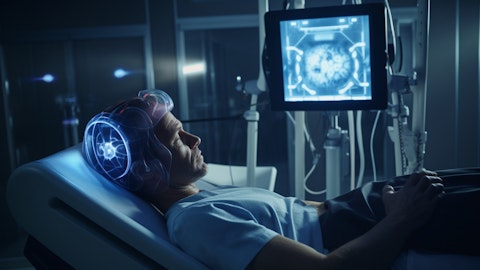Tim Herbert: Great question. And then we’ll come back to you on the question for Rick there. I think the key is learning and, I think, we did it as a pilot program and we positioned it well. We educated the team. But it’s a strong transition for the centers, and while they submit their own prior authorizations, it’s really our responsibility to give them a little bit of support on that, and also the field team being involved in the whole patient flow and tracking patients, where are they now in the process, so we’re really in detail working with the navigators and the physicians to make sure that their patients have the best opportunity, but we need to kind of review this whole prior out. As we continue to scale, we need to continue to encourage centers to be more independent, and we’re going to continue to look at what the best approach to this, maybe it is transitioning with the third party in the interim, there’s several different ways that we can go down this pathway.
The advantage we have going forward, is our technology is evolving significantly with the SleepSync system. So now, we’re in a better position to help patients through the overall process. And, I think that’s going to help us with the education to make sure that we don’t lose sight of patients and when they go into the dark hole. So we’re able to be able to track them going forward. So we’ve learned obviously quite a bit with this process and they’re going to be really able to come back, circle back around. And as we continue to scale, it’s going to be an important step for the organization to take, and we’re well aware of that and we’ll continue to take steps forward. Now come back to you, you had a second follow-up.
Chris Pasquale: Yeah, thank you for that. And then, Rick, just a detailed question. The 29.6 [ph] share count for the fourth quarter, looks like that implies a net loss position for the company. You guys were GAAP profitable last year in the fourth quarter and given the progress you made, seem like you might get there again this time around. So just wanted to clarify if you’re thinking you’ll be in a net loss position in 4Q.
Rick Buchholz: Yeah, we provide annual guidance and we don’t provide quarterly guidance, Chris. And so, we’re going to continue to run our playbook, as I said, we’re going to make those investments. And so, but we are taking a very disciplined approach to spending as we always do. But on an overall basis, we expect to continue to gain leverage. One thing I didn’t point out is, we’re not burning cash. Year-to-date, we’ve actually generated $16 million of cash and our overall cash balance is $467 million. So we’ll give more clarity on that, again, as we get closer to 2024.
Operator: Thank you. And I show our next question comes from the line of David Rescott from Baird. Please go ahead.
David Rescott: Hey, great. Thanks for taking the questions. I wanted to follow-up on or ask on your comments on the expanding coverage with Aetna and Humana. I know you’ve talked in the past about how these newer indications could be somewhat market expansion or, obviously, some of those patients may have been getting prior off in the past as well. So just wondering with the updates you’ve seen or with the expanded coverage you’ve seen so far, whether or not you have increased confidence in the ability for those newer indication expansions to truly be somewhat market expansion, and whether or not you’ve seen any type of at least increase maybe in those accounts already that have seen the indication expansion or that’s still too early.
And then my second question, just broadly, I guess, on the kind of consumer spending segments, that’s we’ve probably gotten a little bit of questions. I’m just wondering a month-and-a-half or so in the Q4, whether or not you’re really seeing any type of weakness at all just from a consumer spending standpoint as it relates to the interest in Inspire procedure. Thank you.
Tim Herbert: Thank you. Let’s go back to expanding coverage. Let’s kind of take these one at a time. And I think they’re kind of key. I think from a high AHI, that’s a pretty easy threshold. These patients just don’t have any other options. And so while we’ve been able to work with payers to try and get a prior authorization approval, that’s not always easy. Aetna is a perfect example. Aetna does not authorize prior authorization. So if you have a patient who’s not indicated for Inspire and has a high AHI above 65, you really don’t have a good pathway going in to get them to give you a special approval. And so those patients tend to get locked out. Now, that they update those policies, the Aetna patients that have an AHI between 65 and 100, do have a pathway forward, that’s really a great step forward.
That will have a strong impact going forward, because there’s obviously a lot of patients in the backlog that with a high AHI, they simply didn’t qualify. And so that I think is a real positive. I think the pediatric patients with Down syndrome is, again, another strong breakthrough. This is a new indication. It’s still in the educational process of building awareness with the families and the physicians. And we’re starting to see a better uptick there. And the good news is most of the key children’s hospitals aren’t associated with other academic or other larger hospitals that already provide Inspire therapy. So it’s a natural growth for those centers to be able to add in this really important patient population, and we continue to do clinical research in that group, as well as to continue to grow the clinical evidence with pediatric population.
When we get to BMI, now we’ve got to be a little careful, because remember with BMI, we’re talking about making sure that they have the proper physiology to receive Inspire therapy. And we talk about if you have too high of a BMI, you have a lateral-wall collapse. That’s what is related to the GLP-1s. And the tongue-based collapse is related to Inspire. The two in combination work together. So if we have patients with a high BMI, we’re going to be very careful to not straight encourage them that they could go today and go get Inspire, because they may have the lateral-wall collapse. That may require them to lose weight, be it a GLP-1 or a bariatric surgery, but we need to be careful with the high BMI patients to make sure that they have tongue-based collapse for which Inspire can treat.




